The Model 12 came to be as the Military & Police Airweight in the early 1950’s. The United States Air Force purchased just over 600 of these prototype, 2” round butt revolvers from Smith & Wesson in 1951, as the Korean War ramped up. These guns were primarily intended for aircrew use and were built with both aluminum frames and cylinders.
In 1953, the Air Force placed an order for 40,000 of these guns with Smith & Wesson. The new guns were designated M13, and were marked on the top strap with a “Revolver, Lightweight, M13” marking.
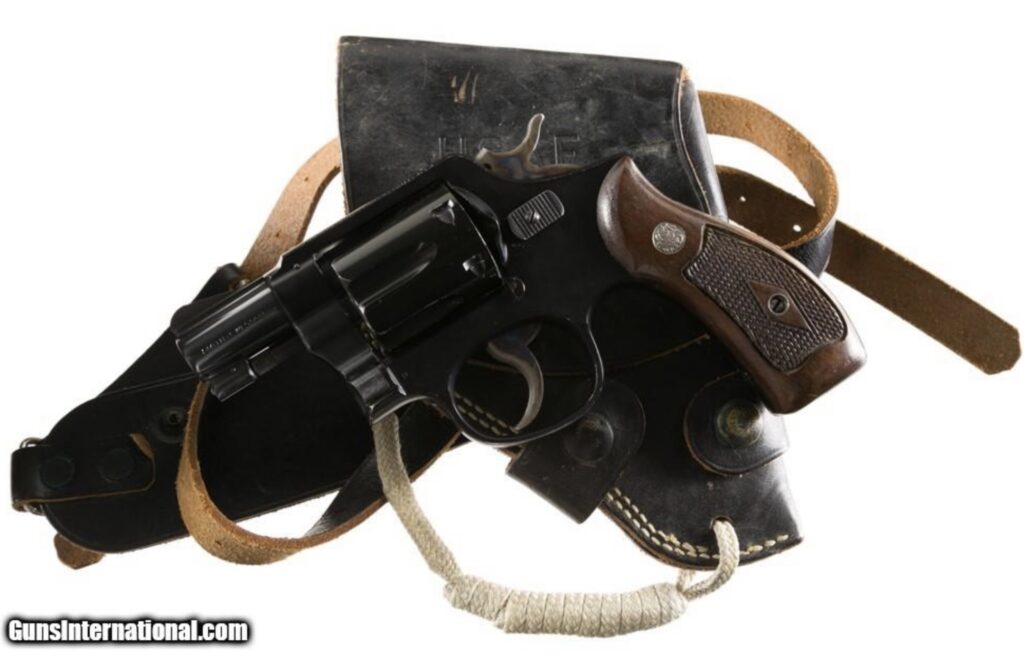
The Air Force soon had problems with the aluminum cylinders cracking, which led to the development of a lower-pressure, M41 ball load that pushed its 130 grain full metal jacket (FMJ) bullet at 720 fps out of the 2″ barrels of the M13s. Unfortunately, this didn’t fix the problem, and the Air Force scrapped the project and destroyed most of their aluminum guns. It’s unknown how many were delivered by Smith & Wesson before this happened.
dead, but not gone
Smith & Wesson kept the M&P Airweight available commercially by swapping the aluminum cylinders for steel, beginning in 1954. The cylinder change raised the weight of the gun from 14 3/8 ounces to 18 ounces, it was still significantly lighter than a steel framed M&P. The factory expanded the choices during the 50’s to include 4-inch barrels and sold both barrel lengths with round or square butts in either blue or nickel finishes (it’s rumored that some were even produced with 5- and 6-inch barrels in the late 50’s- if so, it was very few).
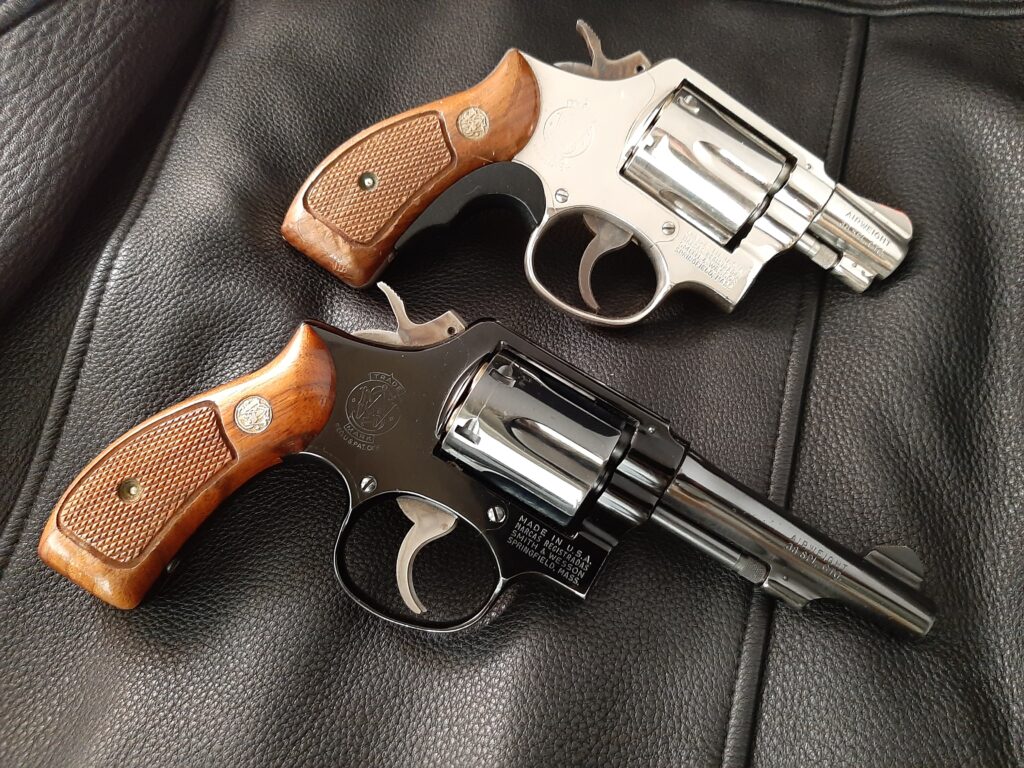
The Airweight K frame received the Model 12 designation when S&W went to numbers in 1957. Like all S&W revolvers, it went through several engineering changes during its production to increase the guns durability and to simplify manufacture. From an end user standpoint, the most noteworthy change occurred in 1962 (12-2) when S&W increased the width of the front sight from 1/10” to 1/8” of an inch (The wider front sight was imminently more useful for fast shooting).
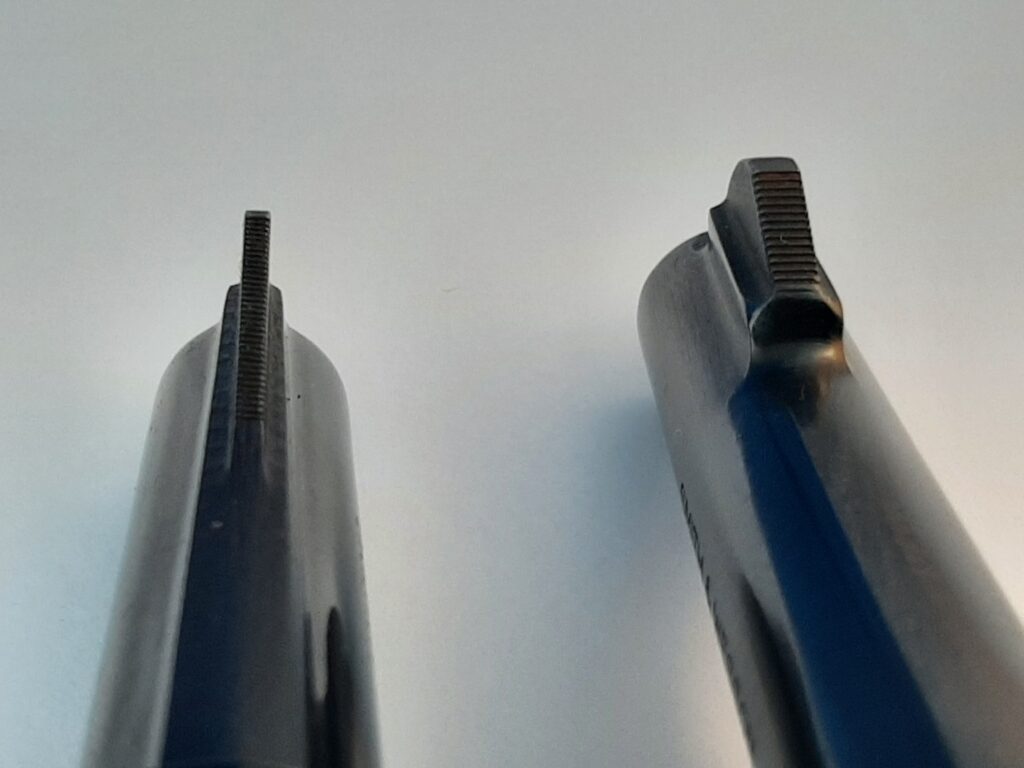
Interestingly, the frame on the Model 12 was .080” thinner than a steel K frame, and the grips were not interchangeable until 1984, when the Model 12-4 production change adopted standard K frame thickness. Up to that point, the hammer and trigger on Model 12’s were also thinner, running .240” vs. .258” on a Model 10.
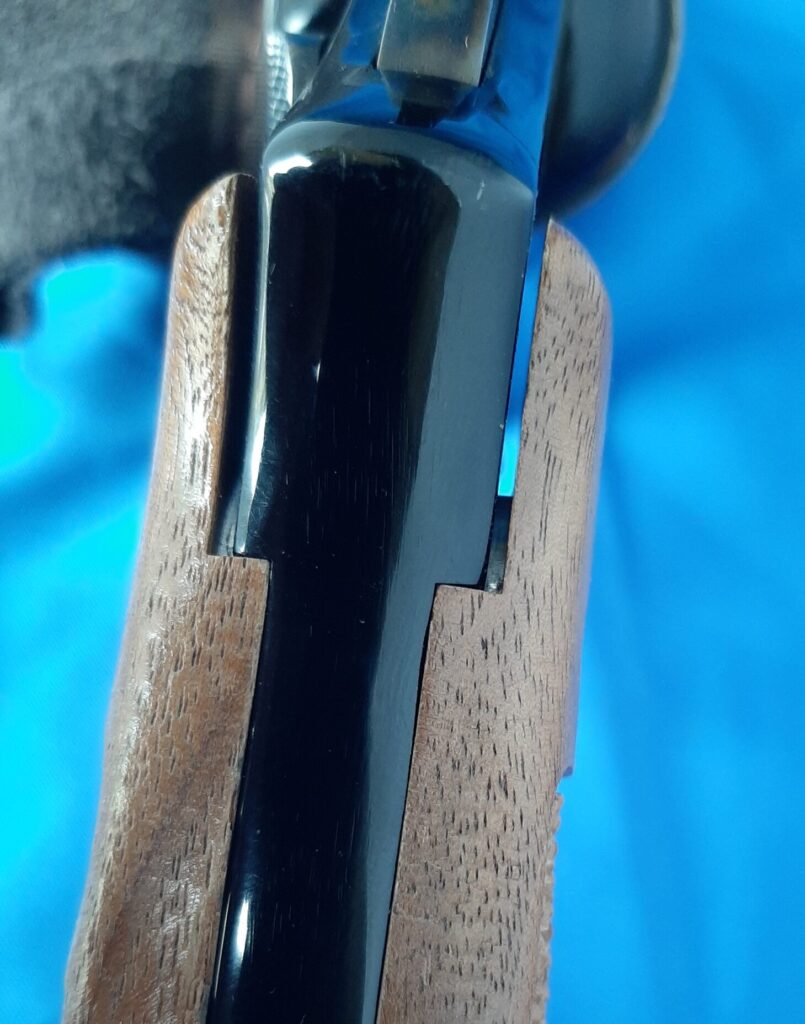
Model 12 production was discontinued in 1986. The Model 12 earned a solid if underappreciated reputation during its thirty-plus year production run. The fact that it is still prized as a carry gun by revolver connoisseurs thirty-five years later speaks for its’ design.
an oldie but a goodie
It’s not unfair to call the Model 12 an old timer, at sixty-nine years of age. It’s a basic, no nonsense carry gun, a lightweight version of S&W’s tapered barrel Model 10. The aluminum frames were assembled and fitted by hand with steel parts by experienced craftsmen. Smith and Wesson built a lot of .38 Special revolvers. They had the bugs worked out by the mid 1950’s and they knew how the post-war “short action” was supposed to feel. They had long mastered sight regulation for the trajectory of 158-grain lead bullets propelled at standard velocity. Model 12’s weren’t fancy, they were simple and they worked.
Feeding the Airweight
These original S&W Airweights were designed around standard pressure loads and were never rated for what we now know as +P ammunition.
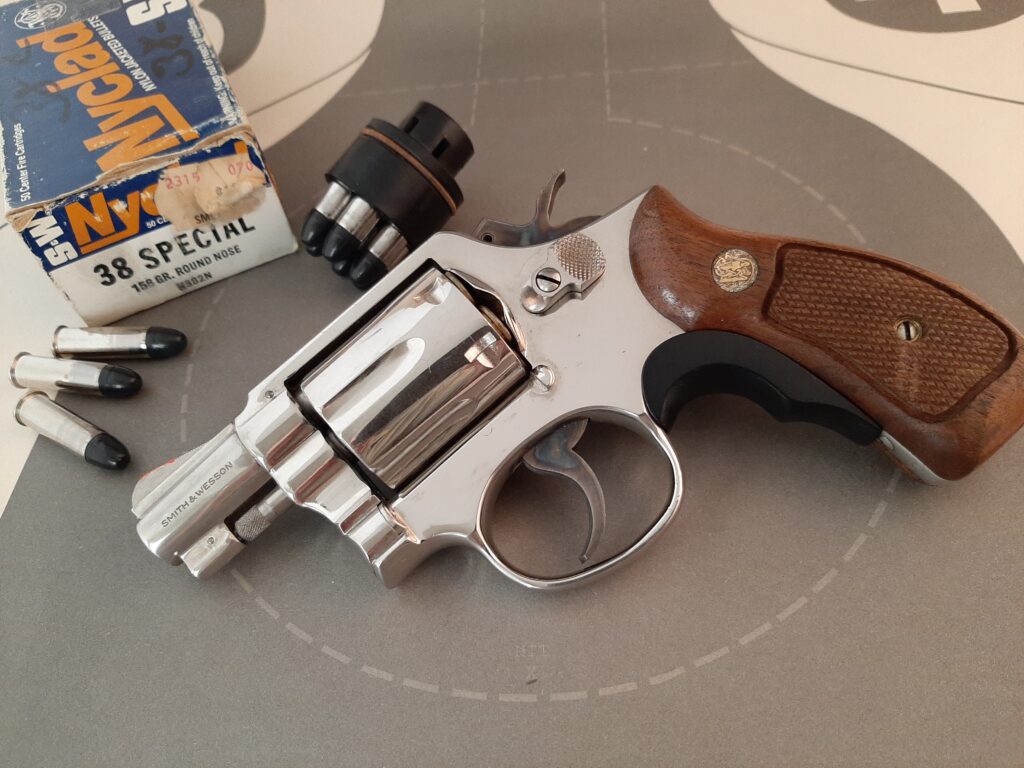
Lead bullets generate less friction than jacketed ones, so higher velocity can be reached at lower pressure with lead bullets. The original spec for the .38 Special cartridge was a 158-grain lead round nose at a nominal 800 fps. You can achieve that in a 2” Model 12 with careful ammo choices. Terminal performance can be improved by changing bullet profiles to a semiwadcutter (SWC), a round nose flat point (RNFP), a semiwadcutter hollowpoint (SWC-HP), or a wadcutter.
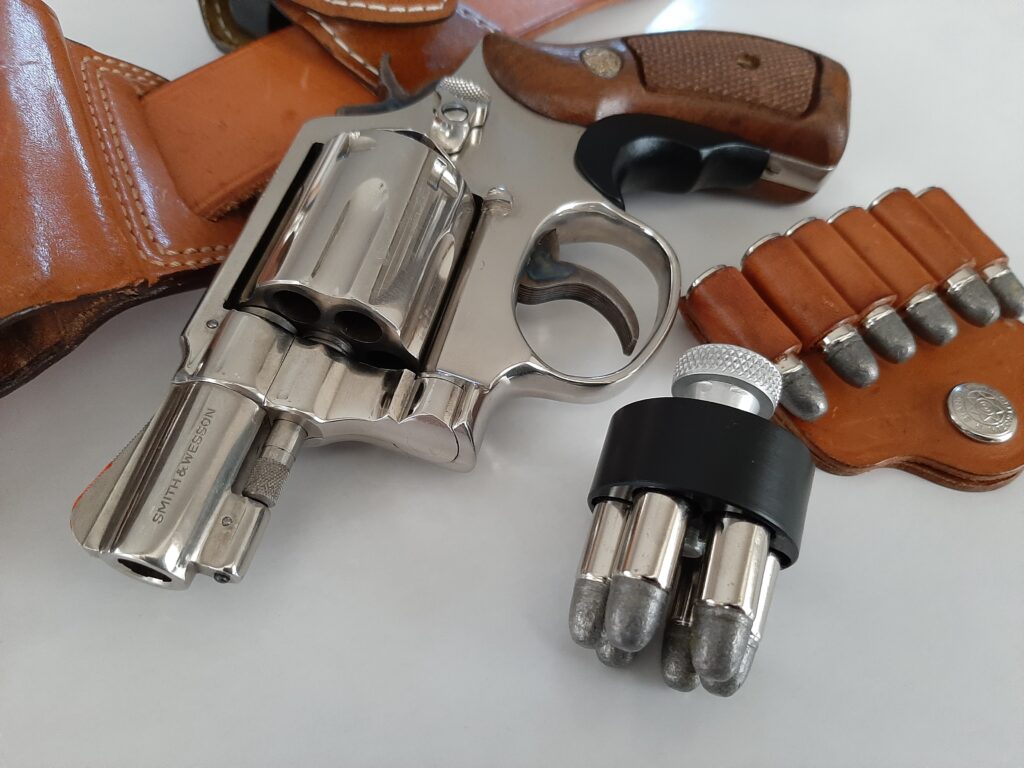
Sticking with lead bullets is a sound practice with a Model 12- it’s tricky to launch jacketed bullets at high enough velocity to expand reliably at standard pressures, especially from a short barrel. Light for caliber (110 gr.) bullets may get there, but they won’t hit to the sights.
My experience
I have had the good fortune to stumble onto a 4” Model 12 and, more recently, a 2” nickel plated one in the last few years. No doubt I looked past plenty of them in gun stores during the last couple of decades. The humble old guns wouldn’t have caught my eye when I was younger and looking for the latest greatest thing. That’s probably best, as I’m not sure I possessed the good sense back then to refrain from pushing the limits with ammo choices. Model 12’s shouldn’t be subjected to hot rodding.
Like lots of used revolvers, the nickel Model 12 that I recently rescued looks a little rough, but is mechanically sound. Its finish is chipped a little on the backstrap and it has some dings and dull spots. The grips are scarred up and the top of the yoke screw is discolored slightly. A collector would probably pass on it. Looking past the exterior, the cylinder is tight with near perfect lock up on every charge hole. The slots on the sideplate screws are clean and sharp and it looked like it had fired about 12 rounds when I bought it. The serial number revealed that it had left Springfield in 1975. The double action trigger pull was as smooth as you would expect for a revolver from that era.
shooting the airweight
I was at the range a while back, trying to find a suitable carry load for a small .357 Magnum revolver. I spent the better part of the morning beating myself up with various magnum loads, seeking one that hit to the sights with acceptable accuracy and recoil. My buddy Mark was very patient with this endeavor.
I finally found one that would work, so I ran a few rounds through the Model 12- almost as an afterthought. I’d been shooting from an informal bench rest with a chronograph at 15 yards, and I continued this with the Model 12. I fired six standard pressure 158 grain lead SWC HP handloads across the screens from that range. I wasn’t expecting much from the short barrel and the rudimentary nickel-plated sights, rolling the shots double action. To my immense surprise, the gun shot an impressive group exactly where I was aiming. Mark made a snide remark about me fooling around with that Magnum when I should be finding a holster for the Model 12. I fired another cylinder of standard velocity, coated, RNFP reloads with similar results. The group wasn’t quite as good, but all six impacted where I was aiming within a 3” circle.
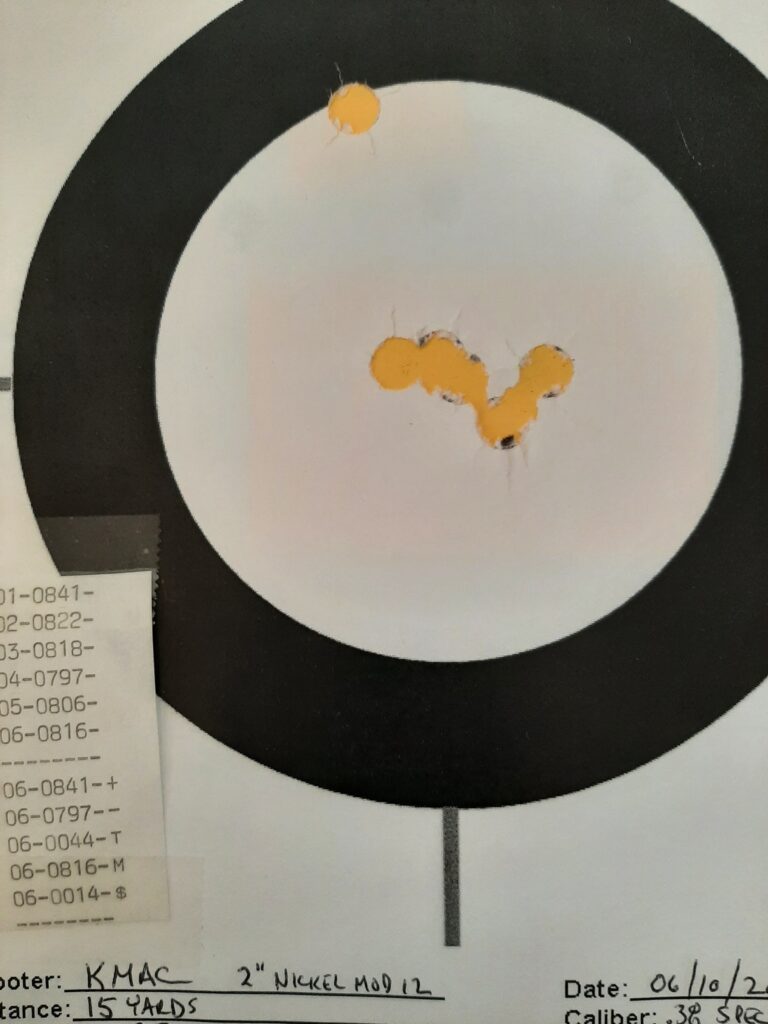
Returning home, I cleaned the Model 12 and put a Tyler T Grip on it. I took the time to paint the front sight and black sharpie the rear. I felt like it had earned some TLC with the way it shot. I went to an indoor range with the Snubby 12 a few days later, with some factory Winchester LRN, Remington SWC, and Remington WC ammo. Again, the Model 12 rewarded me with outstanding performance. The painted sights helped with the poor indoor range lighting (and aging eyes). It delivered the ammo to point of aim with dependable regularity. The size of the sights and the smooth K frame action make this lightweight much easier to shoot well than the average J frame.
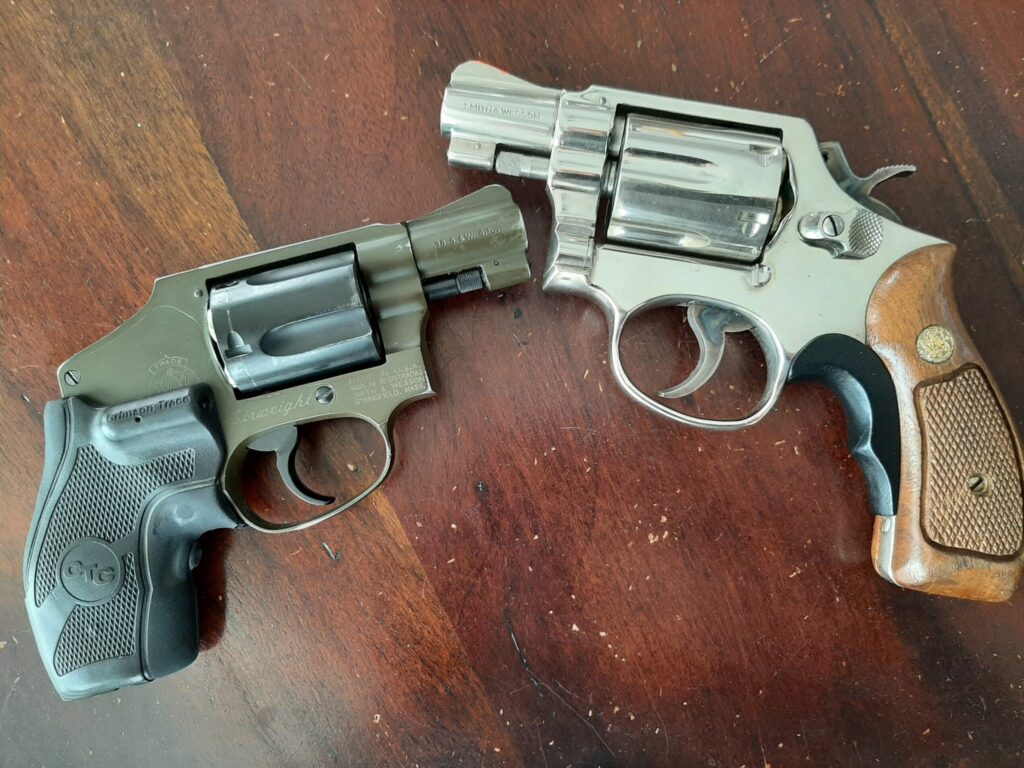
The blast and report of the mild .38 ammo was a welcome change from the last several trips I’d taken to an indoor range with snubby .357 Magnums. The slightly lighter wadcutters also hit to point of aim and had the least amount of felt recoil. They would be a viable option for a defense load from the Model 12. The recoil from the 158 SWC’s was more noticeable from the snub than from a 4” Model 10. It wasn’t awful, but it added up quicker. I shot about 80 rounds, and that was enough.
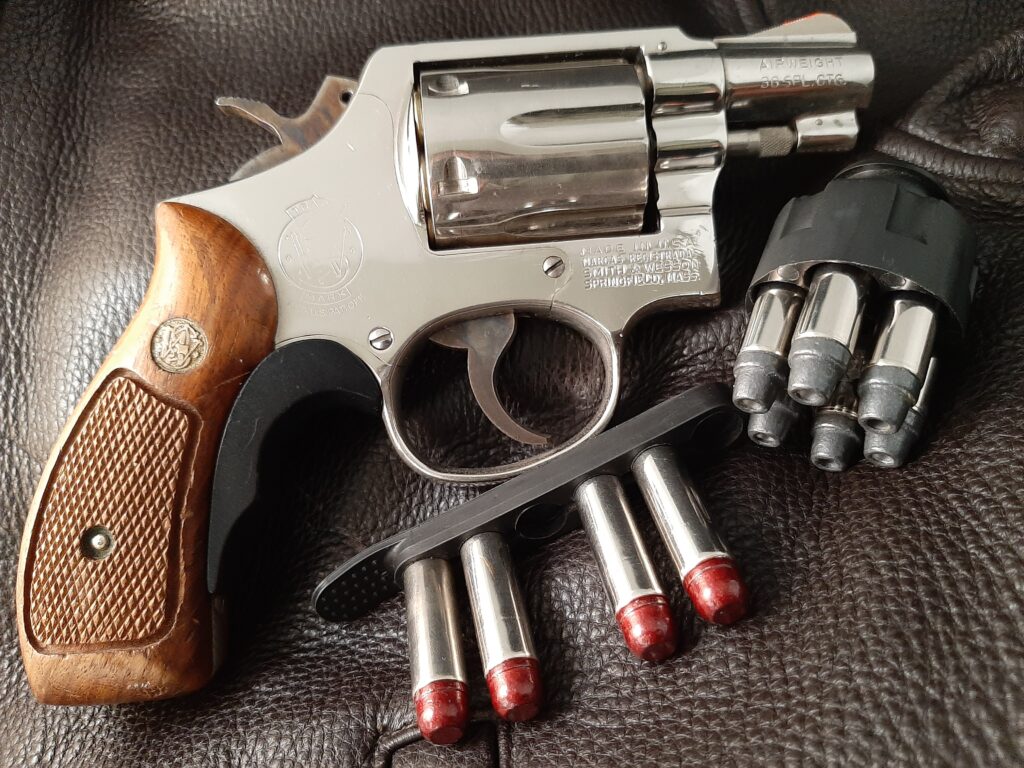
A steel J frame Chief’s Special actually weighs more by an ounce than the Model 12. My mind tells me it should recoil less because it’s a K frame. It handles and shoots like a K frame, but it still kicks like an Airweight. Physics demands that 18-ounce guns kick more than 30-ounce guns, despite how they feel in your hand.
Ammo search
I checked the websites of the big American ammo shops today for Model 12 friendly ammo. Winchester produces 158 grain Lead RN’s, SWC’s, and a flat nose cowboy load, in addition to their 148-grain match WC. Remington lists a 148 gr. Wadcutter as well as a 158 LRN and SWC. CCI markets a 158 LRN in their Blazer line, Nothing from Speer. Federal shows a match wadcutter, and a 158 LRN in the American Eagle line. I was excited to see them also offering a standard velocity 158 gr. SWC HP in their “Train & Protect” line. This would be an excellent choice for a defensive round in a Model 12.
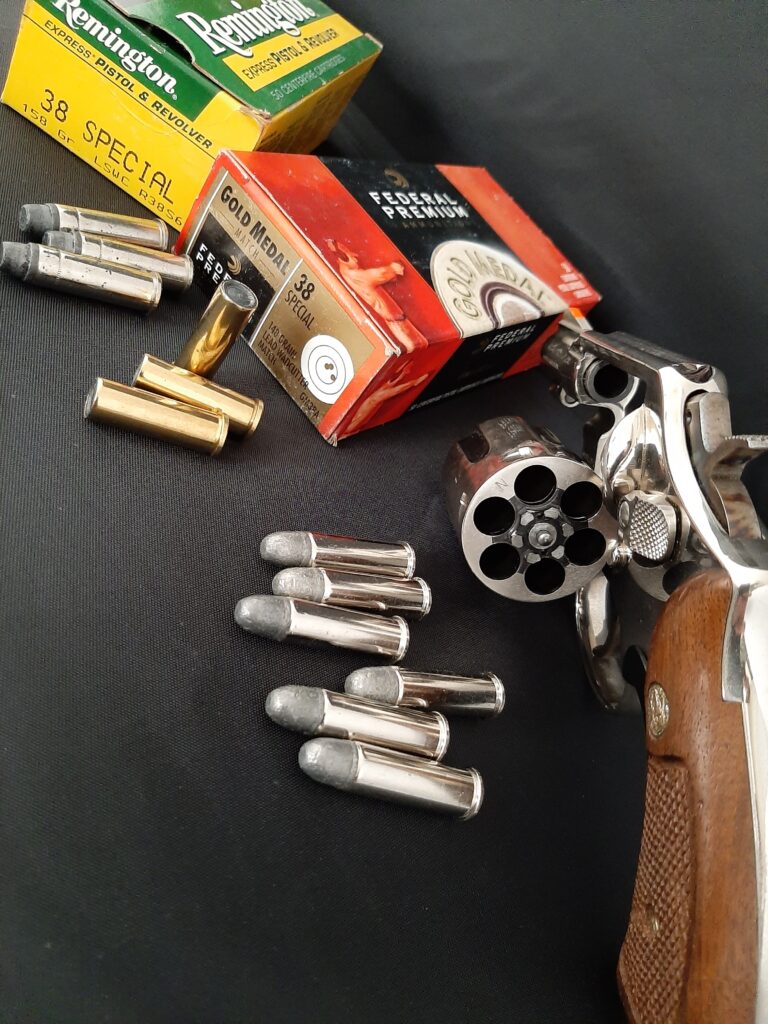
Buffalo Bore offers two solid choices with a 158 SWC HP and a 150-grain hard cast WC both loaded to standard pressure.
Underwood Ammunition also has two promising offerings at standard pressure. A coated 158 gr SWC HP-GC and a coated hard cast 150 gr WC. Nice to see Underwood using Nickel plated cases and coated bullets. The nickel cases weather better for carry ammo and are not affected by verdigris, like brass casings, when carried in leather loops or pouches. The slippery coating on the bullets aids in smooth reloads.
Rolling your own
The RCBS #14 Reloading Manual shows 5.4 grains of Alliant Power Pistol to be a maximum standard pressure charge with 158 grain lead bullets. Power Pistol gives excellent results in the .38 Special with lead or jacketed bullets. It’s clean burning and efficient with low flash and it is not position sensitive in the case. Speer’s Plinker 158 gr. washed SWC HP, loaded in once fired nickel cases, makes a fine carry load. It exits the 2” barrel at 805 fps and hits dead on the sights at 15 yards.
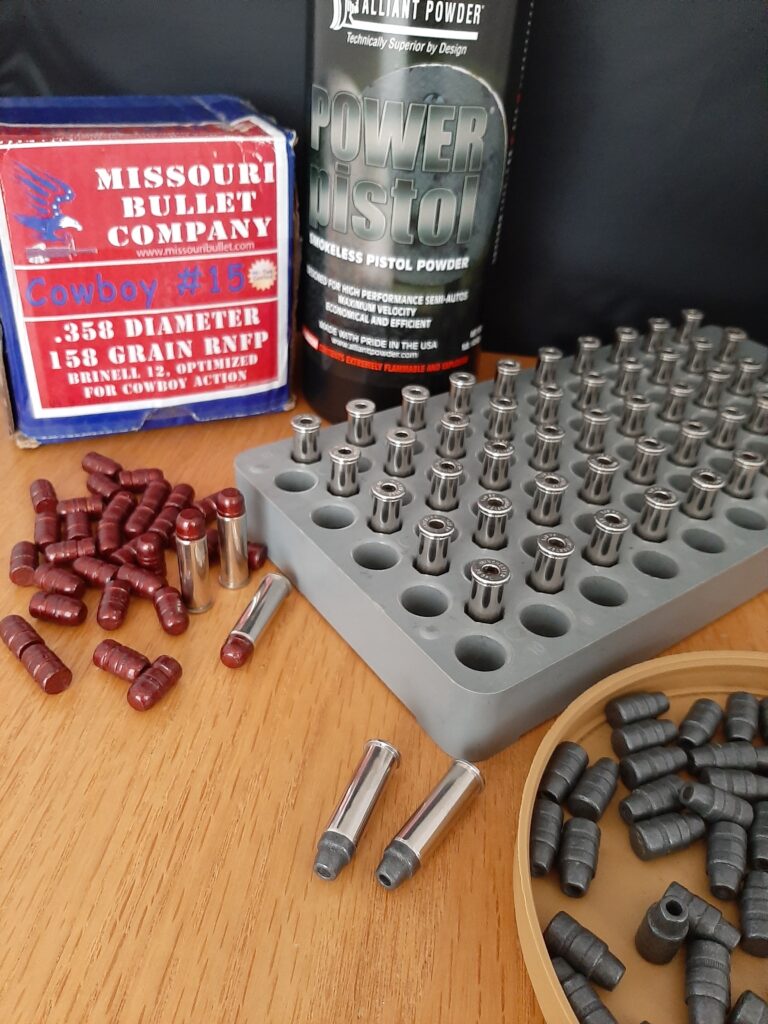
Missouri Bullet Company’s 158 grain coated RNFP on the same charge of Power Pistol is good for secondary loads. The RNFP has a large meplat for shock, but the rounded ogive minimizes hang ups on reloads, especially with the slick polymer coating. They are easier to load from speedloaders than sharp-shouldered SWC’s are, when you’re under stress. They leave the Model 12 at 826 fps and strike point of aim.
new appreciation
Messing with these Model 12’s has shown me why they are so highly regarded. They will remind you that shot placement is more important than magnum velocity or magic bullets. They provide six rounds in a package that weighs as much as many five-round guns. That light weight makes a Model 12 as easy to carry as a J frame, with the right holster. The K frames’ good sights and smooth trigger make them easier to shoot well- a big plus in a concealable handgun. Nickel plating may be old school, but it protects a firearm, carried close to the body, from rust as well as any modern coating.
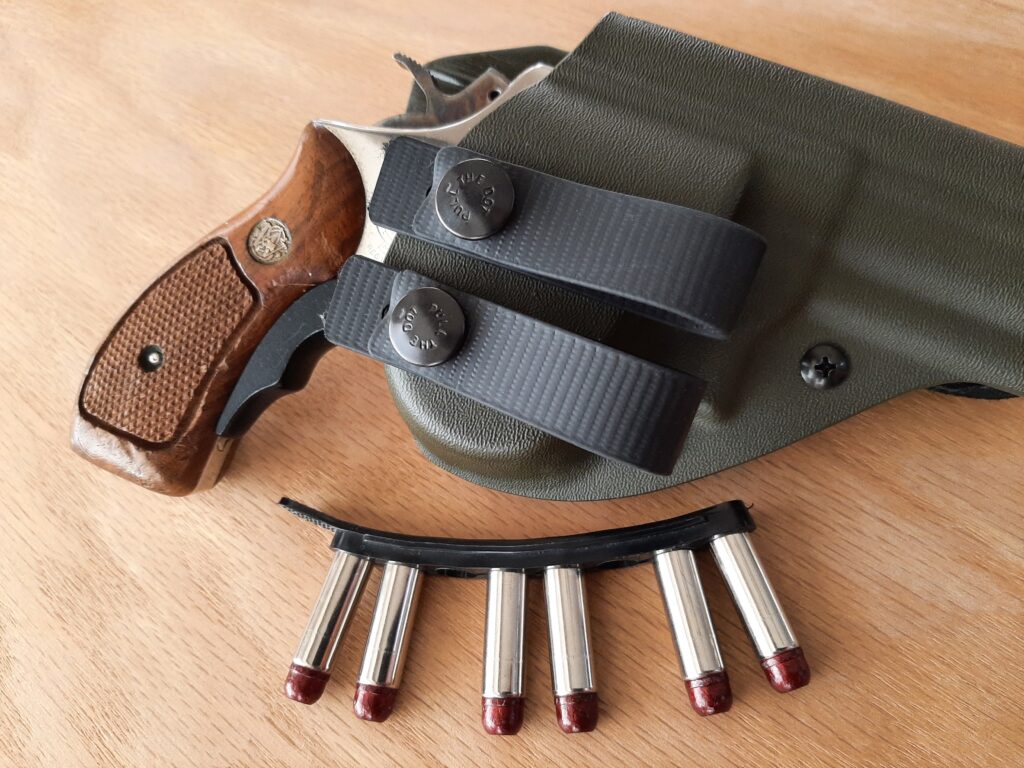
There are lessons to be learned- if you pay attention to old timers.

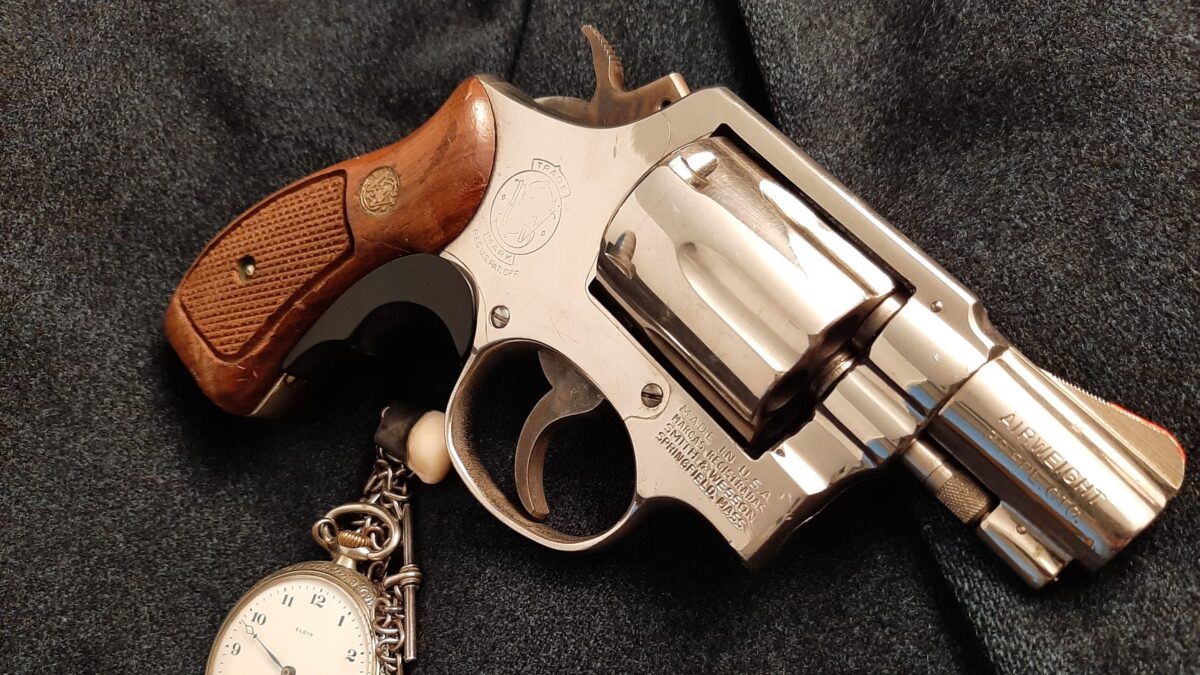
Nice find, Sir! I’d love a four inch version, if I could find one!
Thank you, Sir.
All the old ones are getting harder to find. We would be wise to grab them while we can!
You almost have to wonder what S&W is thinking by not bringing it back in this modern era of most states being shall-issue.
(Hell, make it DAO so they can ditch the damn lock, too.)
We’re on the same wavelength. I typed a similar thought several months ago!
I’m with you there. I mentioned in several places that I’d like to see S&W or Ruger (or, better yet, both) apply their polymer-revolver technology to a K-frame- or Security-Six- sized revolver. It would be the bee’s knees wearing the cat’s pajamas for some of us, um, more seasoned guys who love revolvers but whose misspent youth has left us with chronic injuries and pain that pretty much preclude carrying a 2-pound roscoe all day. I’ve never seen a Model 12 in person but the idea is sound, especially considering the improvements in metallurgy since it was discontinued.
You speak wisdom, Old 1811. I always hope that someone from S&W is paying attention to the comments here at RG- there is a market for this type of revolver!
If S&W pays attention to this thread, I’d buy a new one with a three inch barrel (and a full length ejector) immediately!
No kidding, Comrade. I wish they would bring it back in a modern version- or a classic version. Just bring it back!
My 4″ Model 12 has Ulm Germany proofs and was sold in the Px in 1972. I am told that local private security guards hired by GSA for leased office space used by US Military and State Department used the same contracting documents as in the US, so they could not carry 9mm autopistols, but were armed with .38 revolvers, which Is where the German proofed Model 12 came from. Mine was carried alot, but seldom shot and now does daily duty on the farm.
Your Model 12 has some great history, Outpost. I’m glad those German security guards didn’t shoot their guns much! I focused on my 2″ gun in the story, but I have carried my 4″ gun in lieu of a Model 10 or 67 on occasion. I have to check and confirm it is in the holster sometimes because it weighs so much less than my steel guns! What a great choice for an everyday gun. We are fortunate to have them, they remind me that newer is not always better…
Thank you Kevin for this very informative article on the Model 12s, I learned a lot from it.
Your images are great!
Have one of the “destroyed” Gubiment guns around here somewhere, when I find it ,will send you an image.
Tony
Thank you, Tony! I’m glad you liked it. I would love to see that destroyed gun!
An old timer Model 12 stoked with .38 Special wad cutters would be all the carry piece I’d need. That nickel version is just plain sweet.
Spencer, It’s hard to fault your logic on that choice. I’m not sure we ever did any better…
In mine I load “full charge” wadcutters using the Remington HBWC component bullets with 3.2 grains of Alliant Bullseye, which is standard pressure, but closely approximates the velocity of factory wadcutters from a 4-inch gun, out of a 2-inch snub. If you don’t have the Remington bullets you can load up to 3.5 grains with solid double-ended wadcutters. Don’t try to load other brands of HBWC bullets above 3 grains of Bullseye as it will blow the skirt!
A standard – pressure load safe for the Model 12, which gives reasonable expansion with good penetration uses the Speer 135-graun Gold Dot bullet with 4.2 grains of Bullseye for 770 fps from a 2-inch barrel, approximating the payload and velocity of the Vietnam – era Ball M41, which was developed for these guns. The 135 GDHP requires 750 fps at impact to expand, so in J-frames having shorter 1-7/8″ barrels or in revolvers having barrel-cylinder gaps exceeding Mean Assembly Tolerance, (over 0.006″) you are better off sticking with wadcutters.
Thank you for your wisdom, as always, Outpost75. That bullseye/wadcutter recipe would do just fine for a 2″ Model 12. Or for a lot of other .38 caliber revolvers used for defensive work for that matter! If you want to go with a jacketed bullet, the 135 GDHP is hard to beat.
I wonder how this would compare to a Colt Cobra? I got one of those years for my wife because its light and can hold one more round than a “J” frame. Model 12 to Cobra would be an interesting kind of shoot off.
The Colt Cobra has a true 2-inch barrel of somewhat tighter bore and groove dimensions than the S&W. My experience has been that the tighter .354-.355 groove gives a slight velocity bump compared to an S&W having the same cylinder gap. Expect a Delta-V of 10 fps for each 0.001″ change in barrel-cylinder gap from Mean Assembly Tolerance. Indeed a 2″gun at minimum gap of pass 0.003/hold 0.004 may exceed the velocity of a 4-inch gun at Customer Service Maximum of pass 0.008/hold 0.009″. But today S&W has loosened their permitted tolerances and it is not unusual to find new in box J-frames with gaps of 0.010″ or more. Setting back a barrel on an Airweight frame is problematic, even if done at the factory because the light frames are easily damaged. So take your feeler gages to the gun shop with you and don’t buy a gun over 0.008″ gap or with more than 0.002″ end shake, as determined by comparing two measurements with and without “rear gage” in place.
That was a nice gift you gave your wife, Bill! The Model 12 K frame is a wee bit larger than a Cobra, but I think it comes down to if you like Hartford CT guns or Springfield MA guns. Both have stood the test of time and deserve the fondness we now give them.
I have and regularly carry both the M12 and the Cobra. The 12 is noticeably bigger. It’s not a pocket gun. The Cobra is a bit easier to conceal, but the 12 has a better factory trigger and is a bit less punishing to shoot.
If I’m carrying the gun in a belt mounted holster, I’d pick the 12. If I wanted a good ankle or pocket gun, the Cobra is the winner.
GREAT to see you here, Sir! Welcome aboard! Appreciate the perspective on those two excellent revolvers.
Thank you for your input, Greg. My experience is with S&W’s- not so much with Colts, so it’s good to hear your first hand experience with the Cobra. A tip of the hat your way for being a proponent of carry revolvers in a square gun leaning world, too.
My training mentor advised that 24 is was a practical maximum for pocket carry? That level was defined by a 6-shot Colt Detective Special with 2-inch barrel and Tyler T-grip, being loaded with six 158-grain rounds.
As for the Model 12 being too large, that depends upon how you “dress to the gun”, old school straight-leg uniform trousers, modern BDUs, Duluth Trading “middle management” chinos or Cartharts filling the bill nicely for a big man wearing side-clip suspenders to support the weight of the gun and using one of Bob Mika’s pocket holsters. I have a pair for my 4-inch Model 12 to fit the pockets of my Carhart barn coat and another for the 2-incher for the strong side hip pocket of my Duluth Trading chinos.
The Colt Cobra has a true 2-inch barrel of somewhat tighter bore and groove dimensions than the S&W. My experience has been that the tighter .354-.355 groove gives a slight velocity bump compared to an S&W having the same cylinder gap. Expect a Delta-V of 10 fps for each 0.001″ change in barrel-cylinder gap from Mean Assembly Tolerance. Indeed a 2″gun at minimum gap of pass 0.003/hold 0.004 may exceed the velocity of a 4-inch gun at Customer Service Maximum of pass 0.008/hold 0.009″. But today S&W has loosened their permitted tolerances and it is not unusual to find new in box J-frames with gaps of 0.010″ or more. Setting back a barrel on an Airweight frame is problematic, even if done at the factory because the light frames are easily damaged. So take your feeler gages to the gun shop with you and don’t buy a gun over 0.008″ gap or with more than 0.002″ end shake, as determined by comparing two measurements with and without “rear gage” in place.
Excellent info and advice, Outpost. I’m going to try and beat the rush on feeler gauges you have likely just caused! Seriously, that is a great suggestion to check up front instead of dealing with the disappointment of figuring it out after it’s too late to do anything about it. Thank you, Sir!
Any idea where one can get original or, maybe better, aftermarket grips for a square butt model 12-2? I’ve got one that has some awful plastic grips that must be for a regular K frame. VZ and a few other makers flat out said their grips won’t fit the Model 12. I’ve ordered a T-grip adapter and some standard wood K frame grips from Altamont with the idea of trying to make them fit. Wish Ahrends was still making his fine products! The gun itself is nice – DAO, bobbed hammer, trigger smoothing, chamfered chambers, orange front site insert …
Tom, reach out to Scott Kolar at SK Custom Grips, and see what he says. Tell him we sent you. https://www.skgrips.com
Tom, I’m glad Mike was quick to recommend that grip resource. I was going to advise that you offload that old thing and buy a Glock 48 or some such. I was prepared to come pick it up from you to help you out! Seriously, Your Model 12 sounds like an absolute sweetheart and I hope you find grips and carry it. I seem to recall the old Barami Clip Grip being made for a square butt K frame, too. Anybody out there know if they made one for the older Model 12 frame?
Had the same problem a few years ago with a 2in. square butt 12-3. I had a extra set of grips for a square butt k frame. Get you some sandpaper and any flat surface you can attach the sandpaper to. I stapled the sandpaper to a small scrap 2×4 and started sanding the inside of the gripes. Take your time do one until you get like you want it then do the other. When you get them fitted you can use some Tru-Oil on the inside where sanded. It worked great and looked like a set of factory grips.
Excellent, thanks Mike!
Great article, Great pistols. I am carrying my 2″ M 12 . with a good holster you can forget it’s there.
And we know where to get a good holster! Give Rob and his gang a call, and they’ll set you up with one! Simply Rugged, great stuff, great folks.
Thank you Rob, and thanks for the great revolver holsters and accessories you provide at Simply Rugged.
I just inherited a model 12 4 inch. It doesn’t look like it’s ever been fired.
Wow! What a great gift to inherit, Mr. Mirelez! I don’t think we’ll see its’ like in these modern times, so cherish it and carry it. It should shoot straight with tame 158 grain lead projectiles, I would think. Let us know how it does!
I have a Model 12-2. I pocket carry it in a Mika pocker holster. I always wear cargo pants, so I’ve got roomy enough pockets to fit it.
My preferred carry load for the Model 12 is the Federal 130gr +P HST, because they shoot good and despite being +P the pressure is low enough that I don’t have a problem shooting it in a vintage revolver. For reloads, I usually carry Winchester 110gr Silvertips in a speed loader.
Thanks for the article.
You’re welcome Sir- glad you read it, Axel! Kudos to you for committing to carrying a K frame. That’s a choice lots of people make to carry +P in guns like Model 12’s and shoot them sparingly. That Silvertip is definitely a better speedloader round than the HST. If your day is bad enough that you find yourself having to reload that Model 12, choosing those Silvertips in the speedloader will pay off!
Thanks very much for the excellent article. Much appreciated. I just picked up a nice Model 12-2 Airweight and was wondering if you might know who makes nice wood grips that fit the slightly smaller frame of the 12-2 ? I’ve checked around and so far no luck. Thanks again.
Skyraider, talk to Scott Kolar at SK Custom Grips:
https://www.skgrips.com/
He should be able to help you out. He does beautiful work (stay tuned for the next post—you’ll see what I mean)!
DOL
Thanks much, Skyraider! Mike keeps talking about this Scott Kolar fella, I am now quite excited to see the next post! Glad you found that 12-2!
A bit late to the conversation, but this is a great article & sage wisdom in the comments following. I also have a 12-3 Square Butt bought some years ago, but the only comments I have received were to check the frame for cracks, not to shoot +P ammo in it or defend your life with it. (I carry a 642-2) There exists a lot of disinformation on other forums about the model 12, but everything in your article Kevin is spot on and exactly what I will pass on to my grandkids about this revolver. I use MBC 148gr coated DEWC or Berry’s 125gr PFP over 3.2 gr of BE for the sweet spot with my particular gun at 15 yards. Now that you have stirred my interest again, I am currently searching for an OWB leather lined holster so I can add it to my EDC rotation.
Erick, we’re always glad to get good comments, even if they’re late. Yes, Kevin did a great job on that piece and gave great advice. If you’re in the market for a lined, OWB leather holster, you’re in luck—there are many good choices from Galco, Bianchi, DeSantis, and other production outfits. Our friends at Jeffrey Custom Leather, Andrews Leather, and Simply Rugged Holsters can set you up with a custom piece, instead.
Thank you for your kind comments, Erick. I’m glad you found it of some value. Your handloads sound like they are just right for keeping that Model 12 tight. Something to be said for well placed flat nosed bullets… I have carried a 442 for many moons, but it cannot compare with that 2″ Model 12 for getting good hits. I think your Model 12 in a good belt holster will hide well and be no burden. You will be well armed if you need it! Thanks again.
For some reason (higher bore axis maybe?) I find my minty old Model 12 much less pleasant to shoot than an Airweight ‘J Frame’ with identical loads. Not that it stops me from carrying it in light jacket weather, I even just bought a Rob Leahy Simply Rugged IWB for it which works well.
Hey Mike, that’s pretty wild. I’m trying to think what else it could be if all other factors are the same. Is your J Frame a Centennial? I had not noticed that with K and J frame Airweights. The K frame Airweight is easier to shoot well for me, and I’d do like you and carry it over a J frame in light jacket weather, all day long.
Well…I have a brushed nickle 442, a very old 37 2″ and a nice 37 3″ all of which I can easliy carry under an untucked shirt and find very comfortable to shoot, but the same goes for the steel versions of the same revolvers.
The 4″ Model 12 whilst lovely to look at gives my arthritic wrist more ….something ..torque? …wrenching? than the J’s so I find myself not practicing with it as much.
I’m definitely thinking about buying one of the newish Lipsey’s UC Smiths in 32 H&R., I shot one belonging to a friend the other day and it’s a pusssycat.
I’m going to take a 4″ Model 12 with me to the range along with a 442 and a 3″ 37 and test that for myself, Mike. I had never noticed that, but you sure have me curious about it. I can attest to the 432UC being super mild with most ammo. I only found it’s recoil to be snappy with heavy bullet weight “+P like” loads. Other than that, it as you described.
I’m a bit late to the party here but enjoyed the article and comments very much!
My model 12-3 story follows:
I purchased the gun new at a Scottsdale, AZ. gunshop in 1979. (Blued ‘snubby’).
Only fired it a couple of times before it went into the nightstand. Sold it in 1988 to a female employee wanting protection following a divorce. She also only shot it a couple of times.
After remarrying and after many years, she wanted to sell it and I bought it back! It’s like new but needs the classic, wood grips as they’ve been replaced with rubber Pachmyr grips. Appreciate the tip on who to contact for those!